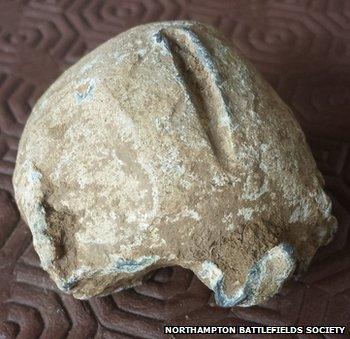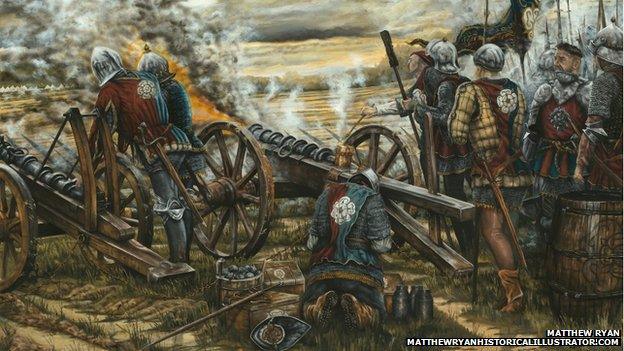'Oldest' cannonball from Roses Battle of Northampton site
- Published

The lead cannon ball is believed to have bounced at least twice and possibly hit a tree
A lead ball found at a medieval battle site could be the oldest surviving cannonball in England, an expert says.
The damaged ball was found at the site of the Battle of Northampton fought during the War of the Roses.
Medieval artillery expert Dr Glenn Foard said: "It is highly likely the projectile was fired during the battle [10 July 1460]."
It will be revealed to the public at a Northampton hotel in Eagle Drive close to the battlefield on Thursday night.
The cannonball was discovered several years ago by Stuart Allwork and was found in his house last year following his death.
Its significance was not realised until protests over plans to put sports pitches on the battlefield site sparked demands for an archaeological survey.
Northampton Borough Council said the cannonball "protects the site of the battle" and would make "a perfect centrepiece" in the visitor centre at Delapre Abbey, which is currently under renovation.
Experts believe artillery was used for the first time in conflict in England at the Battle of Northampton.
Massive impact
The battle led to the Yorkist Edward IV gaining the throne and the downfall of the House of Lancaster headed by King Henry VI.
A Yorkist army of about 15,000 led by the "Kingmaker" Richard Neville, Earl of Warwick, and the 18-year-old Edward, then known as the Earl of March, assaulted between 7,000 and 10,000 Lancastrians in a fortified camp.
As many as 12,000 men were believed to have been killed during the battle.
A new painting of the Battle of Northampton by Matthew Ryan will also be unveiled at the Marriott Hotel conference by Mr Allwork's widow, Jane.

The Battle of Northampton was won by Yorkist Edward IV
The ball is about 3ins (50mm) in diameter and has been analysed by Dr Foard, who said it had suffered massive impact damage from at least two bounces and may have hit a tree.
It is not clear which side fired the cannonball, but some contemporary accounts suggest the Lancastrian guns failed to fire because of the rain - which means it most likely came from a Yorkist cannon.
Mike Ingram, chairman of the Northampton Battlefield Society, said the cannonball was believed to be the oldest surviving in England.
He said the find was of "national significance".
"It confirms the battle as one of the earliest in England where cannons can be shown to have been used," he said.
- Published13 July 2013
.jpg)
- Published19 September 2012
.jpg)
- Published4 December 2012
.jpg)